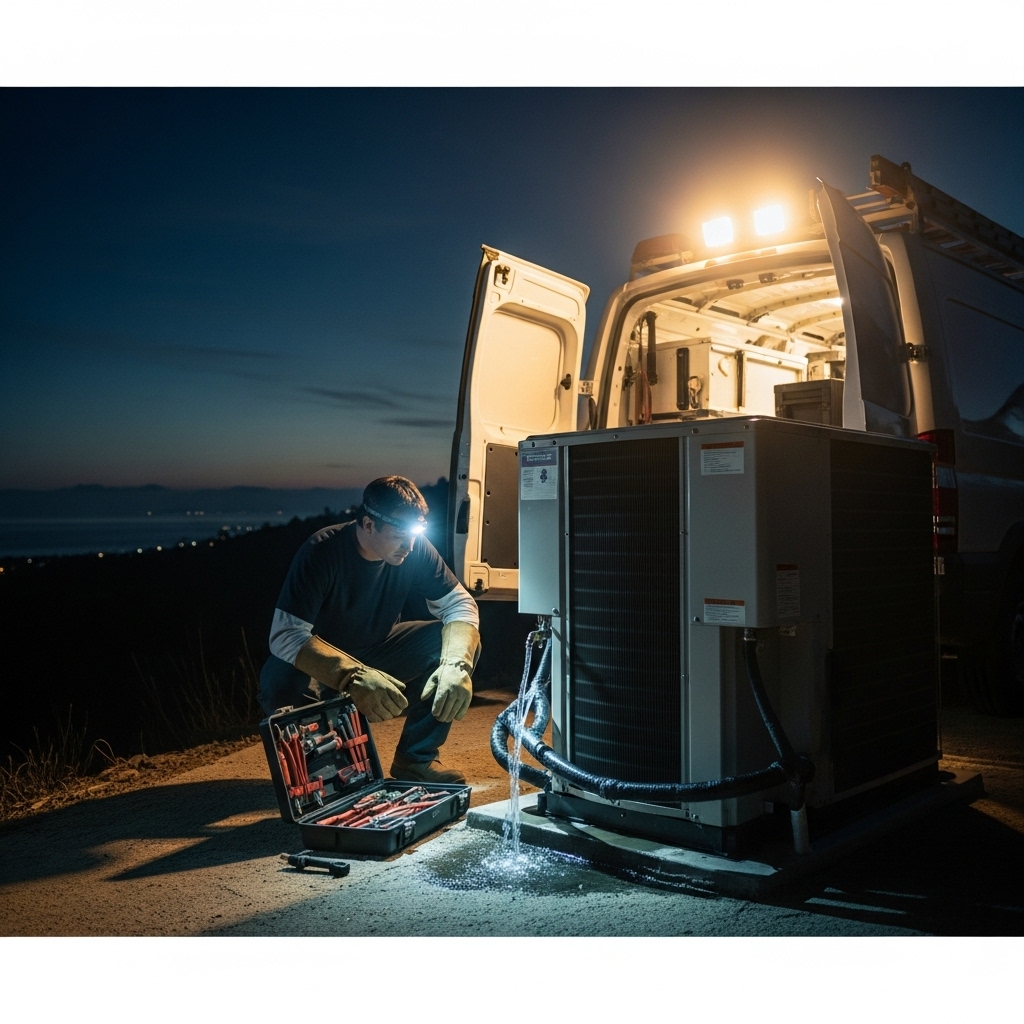When the temperature surges after sunset or a weekend heat wave arrives, a sudden AC failure can feel urgent—especially in Malibu homes with kids, seniors, pets, or sensitive electronics. Emergency air conditioning repair is about more than speed; it’s about safety, clear communication, and stabilizing your home’s environment around the clock. This guide explains what to do first, how to navigate after-hours service, and how to prevent a second emergency once the system is running again. If you’re ready to explore professional air conditioning repair options that prioritize rapid response and thorough diagnostics, the tips below will help you act with confidence.
Coastal systems work under unique stress: salt air, fog, canyon winds, and extended run times during heat spikes. Those conditions can push marginal components over the edge late at night or on a holiday. Knowing the right first steps keeps your home safe and gives your technician the best head start when they arrive.
Immediate Actions When Your AC Stops
Before you pick up the phone, take simple steps to protect your home and document the issue. Small actions can prevent water damage and shorten diagnostic time—two big wins during an emergency.
- Turn the system off if you smell burning, hear grinding, or see water near the air handler
- Check your thermostat for correct mode and temperature settings
- Inspect your air filter; replace if severely clogged
- Verify that breakers haven’t tripped; reset once only if safe
- Clear access to indoor and outdoor units for the technician
- Note the time symptoms began and any unusual weather or power events
Staying Comfortable While You Wait
Emergency response is fast, but every minute counts in a warm home. Simple comfort tactics protect vulnerable people and keep temperatures manageable.
- Close blinds and curtains to reduce solar gain
- Use fans for air movement in occupied rooms
- Limit cooking and heat-producing appliances
- Hydrate frequently and check on pets and family members
- Consolidate activity to cooler areas of the home if possible
What 24/7 Technicians Do Differently
After-hours repair focuses on stabilizing conditions quickly and safely. A seasoned emergency technician triages the system, addresses critical faults, and outlines any follow-up needed during regular hours. The goal is to restore operation or create a safe interim plan.
- Rapid safety checks for electrical and refrigerant concerns
- Targeted diagnostics to pinpoint high-impact failures
- Short-term measures to protect against water damage
- Clear explanations and next steps before they leave
Malibu-Specific Emergency Triggers
Coastal fog, salt, and hillside dust can create issues that show up suddenly: a contactor corroded just enough to fail under load, a clogged coil that finally chokes airflow at night, or a drain line that backs up during extended runtime. Understanding these triggers helps you and your technician move quickly to the fix that matters most.
After-Hours Communication: Set Expectations
When you call for 24/7 repair, share concise details: what you hear, smell, or see; when it started; and any recent weather or power events. Confirm access and leave gate codes if needed. This information ensures the technician arrives prepared and minimizes back-and-forth in the middle of the night.
Preventing Repeat Emergencies
Once cooling is restored, take the opportunity to address underlying vulnerabilities. Emergency visits are teachable moments—your technician can show you where airflow struggled, where corrosion is advancing, and how to reduce strain during the next heat spike.
- Adopt a filter schedule that matches coastal dust and pollen
- Schedule coil cleanings to remove salt film and grime
- Ensure clear condensate drainage and consider cleanout access
- Trim vegetation and maintain clearance around the outdoor unit
- Discuss surge protection if you’ve noticed frequent power fluctuations
Middle-of-the-Night Decisions
Not every late-night symptom means the system must run immediately. If you detect a burning odor, visible leaks, or loud grinding, the safest choice is to keep the system off until a technician assesses it. For mild cooling losses during cooler overnight hours, strategically using fans, closing blinds, and restricting heat sources may keep conditions tolerable until help arrives. If you’re uncertain, a brief phone consultation can guide your next step or confirm that an urgent visit is warranted. When in doubt, rely on a reputable source of AC repair insights and local expertise to inform your decision.
Checklist for 24/7 Visits
Put this list on your fridge or in your phone for quick reference during a stressful outage.
- Power and safety: turn off if you smell burning, see water, or hear grinding
- Thermostat: verify mode, setpoint, and schedule overrides
- Airflow: check filter and clear supply/return registers
- Breaker panel: note any tripped breakers and reset once if safe
- Access: clear paths, secure pets, and share gate codes
- Documentation: list symptoms, times, and any weather or power anomalies
How Long Will an Emergency Visit Take?
Time varies by issue and parts availability, but the focus remains on safe stabilization. Simple airflow or electrical fixes can be swift; refrigerant issues, significant corrosion, or drain complications may require more time or a follow-up when parts suppliers open. The hallmark of a strong 24/7 provider is clarity: you’ll understand what’s possible right now and what’s planned for later.
Frequently Asked Questions
Q: Should I shut off power if I hear a loud buzzing outside?
A: Yes, shut the system off and wait for a technician. A persistent buzz can indicate an electrical component problem that’s safer to inspect with the power off.
Q: Is it okay to run the fan without cooling?
A: In many cases, fan-only mode can improve comfort while you wait, but avoid it if you notice burning smells or suspect electrical issues.
Q: How can I tell if I have a refrigerant leak?
A: Signs include poor cooling, longer runtimes, icing, or hissing. A technician can confirm with proper tools and procedures.
Q: Do coastal homes need more frequent maintenance?
A: Often yes. Salt and moisture accelerate wear, and canyon dust loads filters faster. A tailored maintenance plan reduces emergency risks.
Q: Why does my system fail at night more often?
A: Nighttime humidity or extended runtimes can push weakened components past their limits. The failure may have been building for some time.
Q: Can I prevent drain line overflows?
A: Regular cleaning, proper slope, and cleanout access help. Some systems use float switches to shut down safely if water backs up.
Q: What information should I provide when I call?
A: Describe noises, odors, visible leaks, the time issues began, and any power events. Share access details to avoid delays.
Q: What if parts aren’t available overnight?
A: Your technician stabilizes the system if possible and schedules follow-up promptly. You’ll receive instructions for safe interim operation.
Be Ready Before the Next Heat Wave
Emergency air conditioning repair in Malibu is most effective when you pair quick action with preventive steps afterward. Understand your system’s vulnerabilities, keep filters fresh, and plan coil cleanings that account for salt and dust. With a responsive local partner and a few smart habits, your home will be prepared for whatever the weather brings.
Get Round-the-Clock Malibu AC Help
If you’re facing an urgent cooling problem now—or want to prepare before the next heat spike—connect with a local professional who offers clear communication, rapid response, and thorough diagnostics. For practical guidance and trusted comparisons, explore expert air conditioning repair resources and schedule the help you need.

